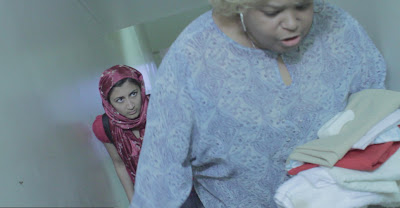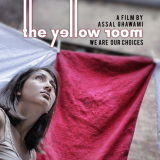Written by Leigh Kolb
Charlotte Perkins Gilman’s “The Yellow Wallpaper,” on its surface, is about a woman in the late 1800s suffering from what we now understand is postpartum depression. Her physician husband locks her away in a room–employing the popular “rest cure” of the time (which Gilman had been forced to endure)–and she slips deeper into depression and eventual madness because of the isolation.
The story is also about the solitary nature of women’s experiences, and how so frequently how women are “dealt” with in society–the treatment–is much more harmful and devastating than the problem itself.
These themes propel Assal Ghawami’s short film, The Yellow Room, which was inspired by Gilman’s story.
The Yellow Room takes place in a tenement house in an American city. Sanaz, the protagonist, is a young Pakistani immigrant who is seeking an illegal abortion from a Latina “medicine woman.” The woman gives her a baggie of four pills and instructs Sanaz to “take two the first hour. When it starts, you put the rest under your tongue.”
She shows her to her room, which is painted a muted shade of yellow. The young woman who appears to be staying in the room also is a foil to Sanaz–angry, loud and threatening. When she finally storms off, Sanaz is left alone, avoiding calls from her boyfriend (and pushing him away when he calls, hanging up when he promises to “help [her] with the baby”).
 |
| Teresa shows Sanaz to her room. |
Much like the protagonist in “The Yellow Wallpaper,” Sanaz is left alone. Her boyfriend doesn’t seem to understand the severity of the situation, or be concerned with what Sanaz wants and needs (just like the husband in “The Yellow Wallpaper”).
Ghawami’s film is beautiful, and I found myself aching for more than 10 minutes. In an interview with RH Reality Check, Ghawami goes in depth in discussing both the technical aspects of the film–it was shot with one lens, and the (perfect) music was composed by a female friend from film school–and the social aspects of it.
 |
| Sanaz must deal with the consequences alone. |
Ghawami–who was born in Iran and grew up in Germany–was inspired to write the film after hearing a story of a woman who had ended her pregnancy with a medicinal herb and thrown the fetus away in the garbage. Instead of judging the woman, Ghawami condemns the society that forces women to choose these routes. She says,
“The Yellow Room, similar to ‘The Yellow Wallpaper,’ is an exploration of an old conundrum. Ultimately it’s the women who deal with the consequences, no matter if you are pro-choice or anti-choice. I just want people to look at the debate from a new angle—from the eyes of the woman who goes through with the experience itself.”
Because film so rarely explores women’s stories (especially about abortion) it’s difficult to find a chance to look through the “eyes of a woman,” tragically. If we had more exposure to those stories, certainly the dialogue surrounding these issues, and even legislation, would be affected.
In Gilman’s “Why I Wrote ‘The Yellow Wallpaper,'” she explains that the “best result” she had from writing the story is that the specialist who prescribed the harsh rest cure had changed his treatment practices since reading the story. Gilman’s story is fiction, although derived from her experiences, but it’s fiction with a social impact. Clearly, women weren’t allowed to tell their stories of isolation and further mental illness in the confines of the rest cure, because not writing or being mentally stimulated was a key part of the “cure.” Women’s stories, of course, are marginalized and often ignored.
In 2013, over a hundred years later, women’s stories about reproductive choice are typically excluded from the national dialogue. Sure, a record number of laws threatening women’s rights to abortion have been proposed and passed in the last few years, but women’s stories are largely absent.
And while we need those stories, we also need art to convey those stories.
Ghawami says:
“I don’t think art needs a cause, but every social cause, hell yeah, needs art! … Films can be a canvas in which we can find our own truth. Art encourages free thinking.”
What the antagonists in both “The Yellow Wallpaper” and The Yellow Room (the protagonists’ families, partners and societies) want is control over the women in the story. To shut a woman into a space, to back her into a corner so her choices are solitary and dangerous, is to, ultimately, control her.
There is hope and freedom at the end of The Yellow Room that we don’t see in “The Yellow Wallpaper.” Ghawami doesn’t make Sanaz a tragic character; she makes her world tragic.
The aesthetics of The Yellow Room are haunting yet beautiful, and the lush strings that accompany Sanaz’s story are jarring yet gorgeous.
The Yellow Room will be screening at colleges and film festivals in the coming months, and at public venues in the New York/New Jersey area. The film’s Facebook page has updates.
Ghawami’s commentary on not only the power of film, but also how the historic literature of women’s struggles connects to the current crisis in women’s rights, gives me great hope that we will see more from her in the future.
The “social cause” of reproductive rights needs art–not just editorials or heavy handed propaganda, but stories. The Yellow Room is a lovely example of how to do the subject justice.
—–
Leigh Kolb is a composition, literature and journalism instructor at a community college in rural Missouri.


A very thoughtful, and well written review of The Yellow Room.
This is so great, Leigh! Thanks for writing it, and I can’t wait to watch the film.
Congrats, wool hoooo!